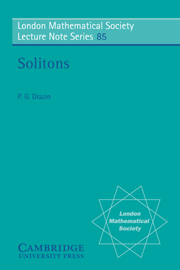Book contents
- Frontmatter
- Contents
- Preface
- Chapter 1 THE KORTEWEG–DE VRIES EQUATION
- Chapter 2 CNOIDAL WAVES
- Chapter 3 CONSERVATION LAWS
- Chapter 4 THE INITIAL–VALUE PROBLEM FOR THE KORTEWEG–DE VRIES EQUATION
- Chapter 5 THE LAX METHOD
- Chapter 6 THE SINE–GORDON EQUATION
- Chapter 7 BÄCKLUND TRANSFORMATIONS
- Chapter 8 EPILOGUE
- Appendix: A DERIVATION OF THE INTEGRAL EQUATION FOR INVERSE SCATTERING
- Bibliography and author index
- Motion picture index
- Subject index
Chapter 1 - THE KORTEWEG–DE VRIES EQUATION
Published online by Cambridge University Press: 25 March 2010
- Frontmatter
- Contents
- Preface
- Chapter 1 THE KORTEWEG–DE VRIES EQUATION
- Chapter 2 CNOIDAL WAVES
- Chapter 3 CONSERVATION LAWS
- Chapter 4 THE INITIAL–VALUE PROBLEM FOR THE KORTEWEG–DE VRIES EQUATION
- Chapter 5 THE LAX METHOD
- Chapter 6 THE SINE–GORDON EQUATION
- Chapter 7 BÄCKLUND TRANSFORMATIONS
- Chapter 8 EPILOGUE
- Appendix: A DERIVATION OF THE INTEGRAL EQUATION FOR INVERSE SCATTERING
- Bibliography and author index
- Motion picture index
- Subject index
Summary
The discovery of solitary waves
This book is an introduction to the theory of solitons and to the applications of the theory. Solitons are a special kind of localized wave, an essentially nonlinear kind. We shall define them at the end of this chapter, describing their discovery by Zabusky & Kruskal (1965). A solitary wave is the first and most celebrated example of a soliton to have been discovered, although more than 150 years elapsed after the discovery before a solitary wave was recognized as an example of a soliton. To lead to the definition of a soliton, it is helpful to study solitary waves on shallow water. We shall describe briefly in this section the properties of these waves, and then revise the elements of the theory of linear and nonlinear waves in order to build a foundation of the theory of solitons. Let us begin at the beginning, and relate a little history.
The solitary wave, or great wave of translation, was first observed on the Edinburgh to Glasgow canal in 1834 by J. Scott Russell. Russell reported his discovery to the British Association in 1844 as follows:
I believe I shall best introduce this ph ænomenon by describing the circumstances of my own first acquaintance with it.
- Type
- Chapter
- Information
- Solitons , pp. 1 - 12Publisher: Cambridge University PressPrint publication year: 1983



